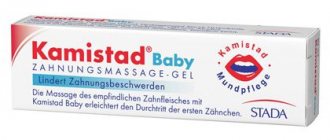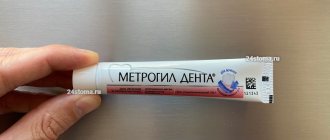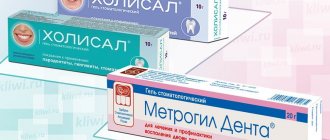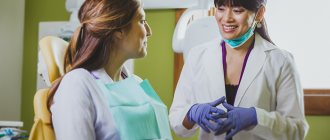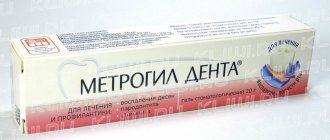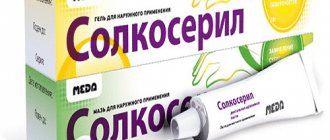Microorganisms that multiply in the oral cavity during caries and gum inflammation can spread throughout the body and lead to the following consequences:
- intrauterine infections,
- exacerbation of inflammatory diseases of the upper respiratory tract,
- indigestion,
- weakening of general immunity,
- increased risk of toxicosis and other complications of pregnancy,
not to mention bad breath, plaque, dryness and cracks in the oral mucosa.
Is it possible to treat teeth during pregnancy?
Most likely, the tooth will decay during this time (the bulk of the minerals go to build the fetal body), damage neighboring ones, and also become a source of infection for the newborn. Let's add a change in the properties of saliva, which, due to its increased viscosity, cannot fully wash and protect teeth, and weak mineralization.
The answer is clear: treat. To do this, you need to choose the right time, place, specialist and materials. The specialists at SM-Dentistry treat their patients very carefully and choose only safe treatment methods.
Metrogyl denta dental gel for gums 20g
Registration number
P N015982/01
Trade name
Metrogyl Denta®
International nonproprietary or generic name
Metronidazole + Chlorhexidine
Dosage form
dental gel
Compound
1 gram of gel contains:
active ingredients: metronidazole benzoate 16.0 mg (equivalent to metronidazole 10.0 mg), chlorhexidine digluconate 20% solution 2.5 mg (equivalent to chlorhexidine digluconate 0.5 mg).
excipients: propylene glycol 50.0 mg, carbomer-980 15.0 mg, disodium edetate 0.5 mg, saccharin 1.0 mg, levomenthol 5.0 mg, sodium hydroxide 4.0 mg, water up to 1 g.
Description
white or off-white opalescent soft gel
Pharmacotherapeutic group
Antimicrobial agent
ATX code A01AB11
Pharmacological properties
The effectiveness of the drug is due to the presence of two antibacterial components in its composition:
a) metronidazole has an antibacterial effect against anaerobic bacteria that cause periodontal diseases: Porphyromonas gingivalis, Prevotella intermedia, Fusobacterium fusiformis, Wolinella recta, Eikenella corrodens, Borrelia vincenti, Bacteroides melaninogenicus, Selenomonas spp.
b) chlorhexidine is an antiseptic and antimicrobial agent, effective against gram-positive and gram-negative aerobic and anaerobic bacteria (Treponema spp., Neisseria gonorrhoeae, Trichomonas spp., Chlamydia spp., Ureaplasma spp., Bacteroides fragilis). Some strains of Pseudomonas spp., Proteus spp. are weakly sensitive to the drug, and acid-resistant forms of bacteria and bacterial spores are also resistant. Does not interfere with the functional activity of lactobacilli. When applied topically, Metrogyl Denta gel is practically not absorbed.
Indications for use
Infectious and inflammatory diseases of periodontal and oral mucosa:
- acute and chronic gingivitis;
- acute ulcerative-necrotizing gingivitis of Vincent;
- acute and chronic periodontitis;
- juvenile periodontitis;
- periodontal disease complicated by gingivitis;
- aphthous stomatitis;
- cheilitis;
- inflammation of the oral mucosa when wearing dentures;
- post-extraction alveolitis (inflammation of the socket after tooth extraction);
- periodontitis, periodontal abscess (as part of combination therapy).
Contraindications
- hypersensitivity to metronidazole, chlorhexidine, nitroimidazole derivatives or other components of the drug;
- diseases of the blood system, including a history;
- diseases of the peripheral and central nervous system;
- children under 18 years of age.
Use during pregnancy and breastfeeding
Due to the lack of clinical data, the safety of the drug during pregnancy and breastfeeding has not been established. The use of the drug during pregnancy is not recommended. During the period of breastfeeding, if it is necessary to prescribe the drug, the issue of stopping breastfeeding should be decided.
Directions for use and doses
Topically, for dental use only.
For inflammation of the gums (gingivitis):
Metrogyl Denta® is applied to the gum area with a thin layer with your finger or with a cotton swab 2 times a day.
After applying the gel, you should refrain from drinking and eating for 30 minutes.
It is not recommended to wash off the gel. The duration of treatment is on average 7-10 days.
For periodontitis:
After removing dental plaque, periodontal pockets are treated with Metrogyl Denta® gel, and the gel is applied to the gum area.
Exposure time – 30 min. The number of procedures depends on the severity of the disease.
In the future, the patient can apply the gel independently. Metrogyl Denta® is applied to the gum area 2 times a day for 7-10 days.
For aphthous stomatitis:
Metrogyl Denta® is applied to the affected area of the oral mucosa 2 times a day for 7-10 days.
To prevent exacerbations of chronic gingivitis and periodontitis:
Metrogyl Denta® gel is applied to the gum area 2 times a day for 7-10 days.
Preventive courses of treatment are carried out 2-3 times a year.
To prevent post-extraction alveolitis:
after tooth extraction, the hole is treated with Metrogyl Denta® gel, then the gel is applied 2-3 times a day for 7-10 days.
Side effect
When using the drug Metrogyl Denta® topically, dental gel, allergic reactions (skin rash, itching, urticaria, anaphylactic reactions, including anaphylactic shock), as well as headache, may occur.
Overdose
Accidental or intentional ingestion of a large amount of gel may cause increased side effects, mainly caused by metronidazole (chlorhexidine is practically not absorbed from the gastrointestinal tract).
The following may be observed: nausea, vomiting, dizziness, and in more severe cases – paresthesia and convulsions.
Treatment:
gastric lavage, symptomatic therapy if necessary.
Interaction with other drugs
When applied topically in recommended doses, no systemic interaction of MetrogilDent® gel with other drugs was detected.
special instructions
The use of Metrogyl Denta® does not replace hygienic brushing of teeth, therefore, during the course of treatment with the drug, teeth brushing should be continued.
The drug should be stored out of the reach of children.
If the drug is accidentally or intentionally swallowed by a child, seek immediate medical attention.
If the medicine has become unusable or has expired, do not throw it into wastewater or onto the street!
Place the medication in a bag and place it in the trash. These measures will help protect the environment!
Impact on the ability to drive vehicles and other mechanisms
There is no information on the effect of the drug on the ability to drive vehicles and engage in other potentially hazardous activities that require increased concentration and speed of psychomotor reactions.
Release form
Dental gel.
5 g, 10 g or 20 g in a plastic laminated tube, the neck of which is sealed with aluminum foil, laminated with polyethylene and with a screw cap made of polypropylene.
One tube in a cardboard box with instructions for use.
5 g, 10 g or 20 g in a plastic laminated tube, the neck of which is sealed with aluminum foil laminated with polyethylene and with a polypropylene screw cap with a protrusion for perforating the foil.
One tube in a cardboard box with instructions for use.
Storage conditions
At a temperature not higher than 25 C.
Keep out of the reach of children.
Best before date
3 years.
Do not use after expiration date.
Vacation conditions
Over the counter.
What to pay attention to when treating teeth during pregnancy
Not every doctor will undertake dental treatment during pregnancy. However, an experienced dentist knows what determines the success and safety of treatment.
At what stage of pregnancy should treatment be carried out?
1st trimester (6-12 weeks). Dental treatment is contraindicated. All organs and systems of the baby are formed; the blood-placental barrier is not formed. Manipulation in the oral cavity can lead to the spread of infection and disruption of fetal development. The ban on treatment especially applies to x-ray examinations.
The exception is diseases in which the main symptom is acute pain. Then minimal intervention is performed to alleviate the condition.
The dentist must be informed about pregnancy, possible allergic reactions, and concomitant diseases.
2nd trimester (13-27 weeks). This is the perfect time to deal with your dental problems. During this period, it is good to carry out the following procedures:
- preventive measures, rehabilitation of potential foci of caries or periodontitis. For example, professional teeth cleaning;
- treatment of gingivitis (inflammation of the gums), which often develops due to hormonal changes and leads to bleeding gums.
- treatment of caries using safe modern materials that do not penetrate the placenta.
- tooth extraction. If the tooth is already destroyed and its removal is indicated, then the procedure is carried out as carefully as possible.
3rd trimester (from 28 weeks).
Again we switch to the most gentle mode. Firstly, the risk of premature birth increases. Secondly, sitting in a dentist’s chair, even the most comfortable one, is no longer very comfortable. The load on the cardiovascular system also increases, which can cause fainting, a drop in blood pressure, or, conversely, a sharp increase in blood pressure.
Description of the drug
If, during dental treatment, the doctor diagnoses gum inflammation, the patients are prescribed antimicrobial drugs. Metrogyl Denta is active against most infectious agents of dental diseases. These are gram-negative and gram-positive anaerobes and aerobes, some types of protozoa. Course use of the drug is recommended for the following purposes:
- prevention of active growth and reproduction of pathogenic microorganisms and their complete destruction;
- preventing the spread of the inflammatory process to healthy tissues of the oral cavity.
Metrogyl Denta is prohibited for use in the first trimester of pregnancy.
Its use is possible only during periods of intensive fetal growth. When the child’s organs are already formed, the ingredients of the drug do not have a negative effect.
pharmachologic effect
Patients often ask dentists whether pregnant women can use Metrogyl Denta gel.
It contains metronidazole, which is not advisable to use while pregnant. But if the dosages are observed, the chemical compound practically does not penetrate into the systemic bloodstream. The action of Metrogyl Denta is based on the pharmacological properties of its ingredients. During biochemical reactions, the nitro groups of metronidazole molecules are restored. This process occurs with the participation of intracellular transport proteins:
- protozoa;
- anaerobic bacteria.
After reduction, nitro groups are integrated into the DNA chains of microorganisms and begin to inhibit the biosynthesis of nucleic acids. As a result, bacteria lose their ability to grow and reproduce, which causes their death. Metrogyl Denta exhibits bactericidal activity against the following infectious agents:
- Borrelia vincenti;
- Fusobacterium fusiformis;
- Eikenella corrodens.
Chlorhexidine exhibits pronounced antiseptic activity. Dissociation of its salt occurs with the formation of cations. They react with bacterial cell walls and disaggregate them. As a result, the osmotic balance is disrupted, the cytoplasmic membranes are destroyed, and the microbes die.
Release form and composition
Metrogyl Denta is produced in India. It is produced in the form of a gel of thick consistency, opalescent, white, with a pleasant menthol odor. The drug is packaged in 5.0 g, 10.0 g, 20.0 g in soft plastic tubes. In addition to metronidazole and chlorhexidine, it contains the following ingredients:
- levomenthol;
- propylene glycol;
- carbopol;
- purified water;
- sodium saccharinate;
- sodium hydroxide;
- disodium salt of ethylenediaminetetraacetic acid.
Due to the content of levomenthol in the gel, after its application you feel coolness, pain and burning disappear. And propylene glycol and carbopol ensure rapid absorption of ingredients into the mucous membranes of the oral cavity. Secondary packaging of Metrogyl Denta is a cardboard box with an attached annotation. The shelf life of the drug is 36 months. The dental product must be stored in a place protected from light at a temperature not exceeding 25°C. The average cost of 20.0 g in pharmacies is 260 rubles.
Dental prevention during pregnancy
- Treatment of carious teeth and periodontitis before pregnancy.
- Careful dental and oral care. In addition to mandatory brushing of teeth 2 times a day with high-quality toothpaste, it is recommended to use dental floss and rinse to prevent gum disease. You can use gels that restore enamel mineralization, reduce sensitivity and stop caries in the early stages.
- Nutrition should be complete; you can supplement it with vitamin and mineral complexes on the recommendation of the obstetrician-gynecologist who is managing the pregnancy and your trusted dentist.
- Preventive examinations in every trimester. Professional cleaning is usually carried out 2 times a year.
Finding your dentist is no less important than finding a gynecologist. When you trust a specialist, any manipulation will be easy and positive, which will definitely have a positive effect on the health of both mother and child.
Instructions for use of METROGYL DENTA® (METROGYL DENTA®)
A drug with antimicrobial action for topical use in dentistry.
In periodontitis, anaerobic bacteria are considered the predominant causative factor. Therefore, it is desirable to use pharmaceutical treatment specifically effective against periopathogenic anaerobic microflora instead of using broad-spectrum antibiotics with the associated risk of developing bacterial resistance and gastrointestinal complications. Metronidazole is a chemotherapeutic agent with activity against anaerobes such as Bacteroides species and spirochetes, which are widely believed to be the main pathogens associated with periodontitis.
Metronidazole
Metronidazole is a 5-nitroimidazole derivative with activity against anaerobic protozoa and anaerobic bacteria.
Mechanism of action.
After metronidazole enters the body, it is reduced by intracellular electron transfer proteins. As a result of this change, a concentration gradient is maintained in the metronidazole molecule, which promotes intracellular transport of the drug. It is assumed that free radicals are formed, which in turn react with cellular components, and this leads to the death of the microorganism. Anaerobic bacteria associated with periodontal disease, such as Porphyromonas gingivalis, Prevotella intermedia, Fusobacterium nucleatum and Wolinella recta, are highly sensitive to metronidazole. The lowest concentration of metronidazole required to inhibit 50% of strains (MIC50) is below 1 μg/ml for the corresponding anaerobes. Topical metronidazole may produce higher subgingival concentrations than those achieved with systemic administration. Therefore, a lower dose of the drug will be required.
Microbiological analysis included determination of total anaerobically culturable bacteria and the relative proportions of anaerobes, aerobes, black pigmented anaerobic gram-negative rods, Actinobacillus actinimycetemcomitans, streptococci and spirochetes.
Both treatments resulted in a significant reduction in pocket depth. The decrease in GDC was statistically significant during treatment and during subsequent visits to the doctor (p < 0.00001). Metronidazole gel tended to be a better treatment than stone removal throughout the period. The reduction in bleeding on probing was statistically significant during treatment and during follow-up (p<0.02).
Chlorhexidine gluconate
Chlorhexidine is a disbiguanide antiseptic and disinfectant with bactericidal or bacteriostatic action against a wide range of gram-positive and gram-negative bacteria.
Mechanism of action.
At physiological pH, chlorhexidine salts dissociate, releasing a positively charged component. The bactericidal effect of chlorhexidine results from the binding of these cationic molecules to the negatively charged walls of bacterial cells and extramicrobial complexes. In low concentrations, chlorhexidine causes an imbalance in the osmotic balance of bacterial cells and the leakage of potassium and phosphorus, which gives a bacteriostatic effect. At high concentrations of chlorhexidine, the cytoplasmic contents of the bacterial cell are precipitated, which leads to its death.
Several hypotheses have been put forward regarding the mechanisms of action of chlorhexidine in relation to plaque inhibition.
1. Binds to bacteria that form oral plaque and affects their absorption by teeth.
2. Binding to glycoproteins in saliva and reducing pellicle formation and plaque colonization.
Chlorhexidine is poorly absorbed through intact skin or from the gastrointestinal tract. Does not accumulate in the body and is only minimally metabolized. If swallowed, chlorhexidine is primarily excreted in the feces. There are reports that extensive use of chlorhexidine for over 20 years has provided no evidence of absorption through intact skin.
The role of Metrogyl Denta® gel
The effectiveness of the drug is due to the presence of two antibacterial components in its composition:
- Metronidazole has an antibacterial effect, is active against anaerobic bacteria
that cause periodontal diseases: Porphyromonas gingivalis, Prevotella intermedia, Fusobacterium fusiformis, Wolinella recta, Eikenella corrodens, Borrelia vincenti, Bacteroides melaninogenicus, Selenomonas spp. - chlorhexidine is an antiseptic and antimicrobial agent, active against gram-positive and gram-negative aerobic and anaerobic bacteria
(Treponema spp., Neisseria gonorrhoeae, Trichomonas spp., Chlamydia spp., Ureaplasma spp., Bacteroides fragilis). Some strains of Pseudomonas spp., Proteus spp. are weakly sensitive to the drug, and acid-resistant forms of bacteria and bacterial spores are also resistant. Does not interfere with the functional activity of lactobacilli.
When applied topically, the active substances of Metrogyl Denta® gel are practically not absorbed.
Metrogyl Denta® gel includes a suspension of metronidazole benzoate with propylene glycol. When applied, the gel flows and fills the dental pocket. Upon contact with the aqueous portion of either gingival cavity fluid or saliva, which contains esterases, it hydrolyzes the microbiologically inactive metronidazole benzoate into free metronidazole and benzoic acid. Metronidazole has an aerobicidal effect on bacteria located in the periodontal area. Metronidazole also has anti-inflammatory activity, which targets inflammation associated with periodontal disease.
Chlorhexidine is an antiseptic and disinfectant and has a bactericidal and bacteriostatic effect on a wide range of bacteria.
Metrogyl Denta® is active against aerobic and anaerobic flora present in the oral cavity and, in particular, in the gum pockets.
Systemic metronidazole at doses of 750-1000 mg/day for 2 weeks is known to reduce the growth of anaerobic flora, including spirochetes, and reduce the clinical and histopathological signs of periodontitis. Metronidazole, when used in addition to thorough scaling and root planing, significantly reduces the need for surgery compared with mechanical scaling alone. Topical metronidazole in gel form reaches high concentrations locally around the gum tissue and is therefore very effective. The simultaneous use of topical metronidazole helps to avoid side effects with long-term use of metronidazole in the mouth.
Taking into account the fact that oral infections are mixed in nature and are usually caused by aerobic and anaerobic bacteria, and the disease is chronic, long-term use of oral antibacterial agents can lead to side effects and the risk of developing bacterial multidrug resistance. In such cases, topical treatment containing a combination of antibacterial agents acting on aerobic and anaerobic bacteria simultaneously (metronidazole benzoate 1% and chlorhexidine gluconate 0.25%) is of paramount importance.
Again considering the involvement of aerobic and anaerobic bacteria in periodontal disease, the combination of metronidazole benzoate and chlorhexidine gluconate would have an important therapeutic advantage over chlorhexidine gluconate alone.
